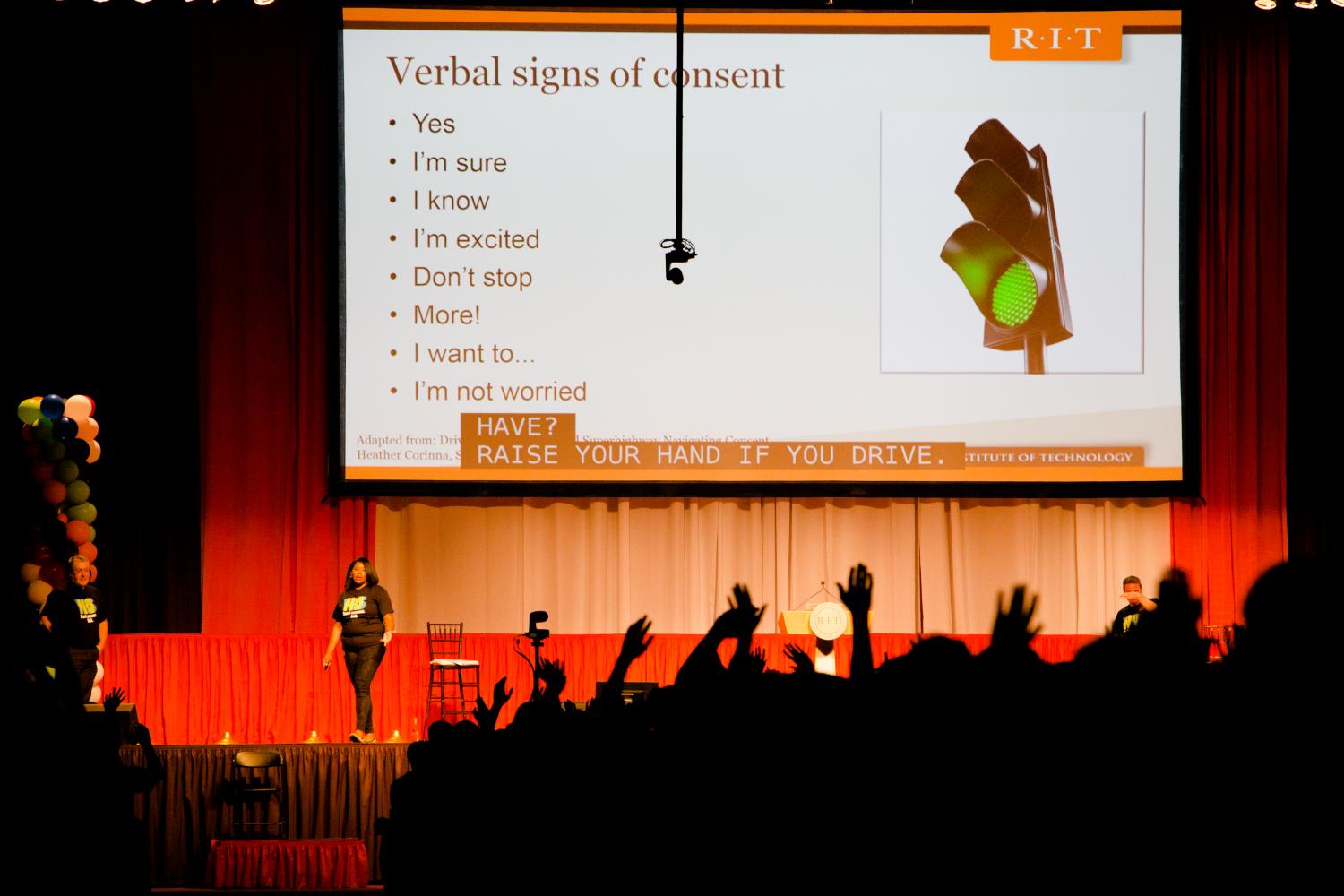The RIT administration has faced sharp scrutiny from the campus and the outside community since the image of a slide from "Alcohol and Chill," a Title IX PowerPoint presentation given during orientation, went viral. The now infamous picture features Roo, the baby kangaroo from Winnie the Pooh, alongside the acronym ROO, which stands for “rub one out.” Current students, alumni and outsiders took to social media to express their thoughts on the slide while dozens of news outlets, including The Cut, Refinery29 and Teen Vogue ran stories on the presentation. Most were negative, blasting the institute for using a children’s character to suggest that masturbation could prevent sexual assault.
In response to the backlash, President David Munson promised that the university would work to better take sensitivities into account in the future, while Sandra S. Johnson, the senior vice president for Student Affairs, issued a statement apologizing to those that had been offended by the presentation.
However, the team that worked to create the presentation, which included the Student Counseling and Psychological Services Office, the Center for Student Conduct and Conflict Mediation, the Center for Women and Gender and the Office of the Title IX Coordinator, still stand by the program. It is their belief that many of the adverse reactions have come as a result of the message being misinterpreted and taken out of context.
“People are really upset," acknowledged director of RIT's Center for Women and Gender Darci Lane-Williams. "They’re assuming that RIT is saying that men can’t control themselves — they associate 'rub one out' with men — and what we were telling all these students is that if you can’t control your desire to rape, if you masturbate, that will help you control your desire to rape, and that is what people are outraged by ... and I would be outraged by that too. As someone who’s an advocate and also educates on this topic, that is ... NO. That is totally not what we’re saying.”
Background on RIT’s Title IX Presentation
RIT began holding large Title IX presentations in 2013 as part of a multi-faceted plan to educate new students that also includes an invitation to complete Campus Clarity’s “Think About It,” an online module, and various programming throughout the year. However, feedback collected from the past few presentations hadn’t been very positive. “Initially, we had two speakers come in: one was a survivor of assault and the other woman was her best friend, and they talked strictly about assault ... The students would leave and not have very many tools to use going forward. We would have counselors at the back of the Field House to catch people literally running out because they were triggered by what they were hearing,” Lane-Williams recalled.
The speakers presented an account of the assault in detail, a very heavy discussion, but feedback showed that students didn’t identify with the message or leave with information they could use in the future, and many of them had sat through similar discussions while in high school. These traditional conversations and survivor stories don’t often resonate because students struggle to put themselves into the given scenario. Additionally, because the majority of assaults that happen on campus result from a lack of communication around consent versus the “standard assaults” that are violently depicted on TV, the topics were not being addressed from an appropriate angle.
Taking this feedback into consideration, Lane-Williams and the team working on this year’s presentation sought to change the conversation and develop a strategy to better engage the audience. “We knew that we had to engage the students in a way that they would pay attention, that they would see themselves in the situations that we were creating, but also not feel like we were accusing them of being potential victims and rapists,” Lane-Williams explained.
“We knew that we had to engage the students in a way that they would pay attention, that they would see themselves in the situations that we were creating, but also not feel like we were accusing them of being potential victims and rapists."
Controversially Changing the Conversation
Among the tactics employed for this year’s presentation were roleplaying, the use of a stoplight metaphor and live-polling. Because the presenters only had 90 minutes to cover an extensive amount of material, live-polling allowed them to gauge the students’ familiarity with different topics. “We were able to kind of prompt the presentation discussion and pivot, if necessary, based on the audience’s perceptions and feedback from the online polling,” Johnson said.
The conversation largely shifted to consent and communicating with sexual partners after 88 percent of the 1,500 students participating in the live poll responded "No" to the question, “Do you believe people clearly articulate what they want sexually?” During this part of the presentation, the presenters focused on how to prevent sexual assault by determining what consent really means. They honed in on affirmative consent which, since N.Y.’s passage of the “Enough Is Enough” legislation in 2015, has switched the conversation from “no means no” to “yes means yes.”
Prior to the slide that has sparked so much controversy, presenters focused on what Lane-Williams referred to as the “Tao of Pooh.” She explains that the introduction of this philosophy was to emphasize once someone has withdrawn consent, there is nothing you can do to change that because everyone holds the right to withdraw consent at any point in time. Lane-Williams also acknowledged that everyone has the right to be sexually gratified, but asserted that it is never at the expense of another person. “If you find yourself with a partner who has withdrawn consent and you are frustrated, you need to leave," she said. "You don’t need to try later, you don’t need to stick around and see if you can coerce or harass the person into doing something, you need to leave. And if you find yourself still sexually frustrated, that’s when you rub one out ... that’s how [Roo] got put in there.”
“If you find yourself with a partner who has withdrawn consent and you are frustrated, you need to leave ... and if you find yourself still sexually frustrated, that’s when you rub one out ... that’s how [Roo] got put in there.”
Reactions to Roo
While the Title IX policy development team may have had good intentions for the Roo slide, it missed the mark for many viewers. Jordan Westhoff, a 2015 graduate from the Motion Picture Science program, heard about this year’s presentation when the images of the Roo slide lit up social media. “I assumed it was satire, but I unfortunately realized ... that it was completely serious,” he said. “I’m not certain that using a children’s cartoon and suggesting that gratification is the solution to a very deep problem is really the best way to teach incoming freshman.”
While he concedes that humor is frequently used to introduce a challenging topic, he points out that it has a tendency to water down the message. Johnson acknowledged this point as well. “The Roo image was used to communicate a message, but with some humor, and we know that the line [between the appropriate and inappropriate use of humor] can be hard to manage," she said. "We are obviously going to be much more sensitive to the use of images in the right way because we don’t want to actually diffuse the importance of the message itself.”
Westhoff also contrasts the tactics used for this year’s presentation with those used for the three Title IX presentations he attended, one as a freshman and then two as an orientation assistant. He recalls the very serious, impactful nature of the programs he attended and suggested that the administration would have been able to more effectively and relevantly present the information by addressing the issues for what they are. “Sexual assault is no different from a physical assault, you know, other than how it’s carried out," he said. "I don’t necessarily think the school would joke about committing assault and battery in the way that they conducted this kind of explanation.”
"I don’t necessarily think the school would joke about committing assault and battery in the way that they conducted this kind of explanation.”
James Duckworth was among those on the receiving end of this controversial Title IX presentation. The first year Mechanical Engineering Technology student was not at all expecting consent to be introduced in such a unique way. He initially found the Roo slide humorous, but understands that for many people, both in the audience and not in the audience, it was insensitive and offensive. He suggests that this is largely in part because it has been taken entirely out of context, particularly on the internet. “Most of [the online conversation] is really focused on that one particular slide," he said. "So when you’re not actually at the presentation and you just see the picture of that one slide, you probably think, ‘What is wrong with this college?’”
Although Duckworth doesn’t necessarily agree with the use of the character Roo or the ROO acronym for sexual assault prevention, he surmises that the university used them with the idea that it would help students remember the program. In that regard, they have certainly succeeded.
Overall, the idea behind this year’s presentation and the controversial slide featuring Roo alongside “rub one out,” was to leave new students with the tools required to more effectively communicate their needs, wants and desires and better navigate sexual situations. Although the university has faced harsh criticism for the way they chose to address the topics, Lane-Williams is satisfied with one thing. “People are talking about sexual assault in ways that we don’t typically see,” she said.










